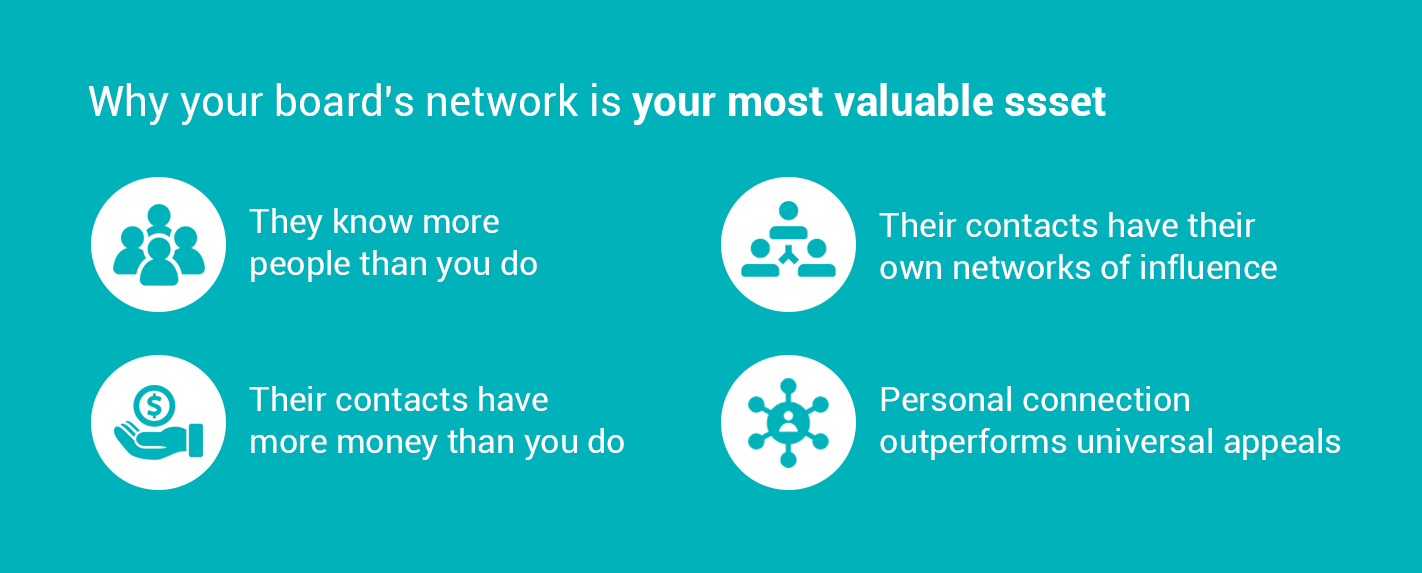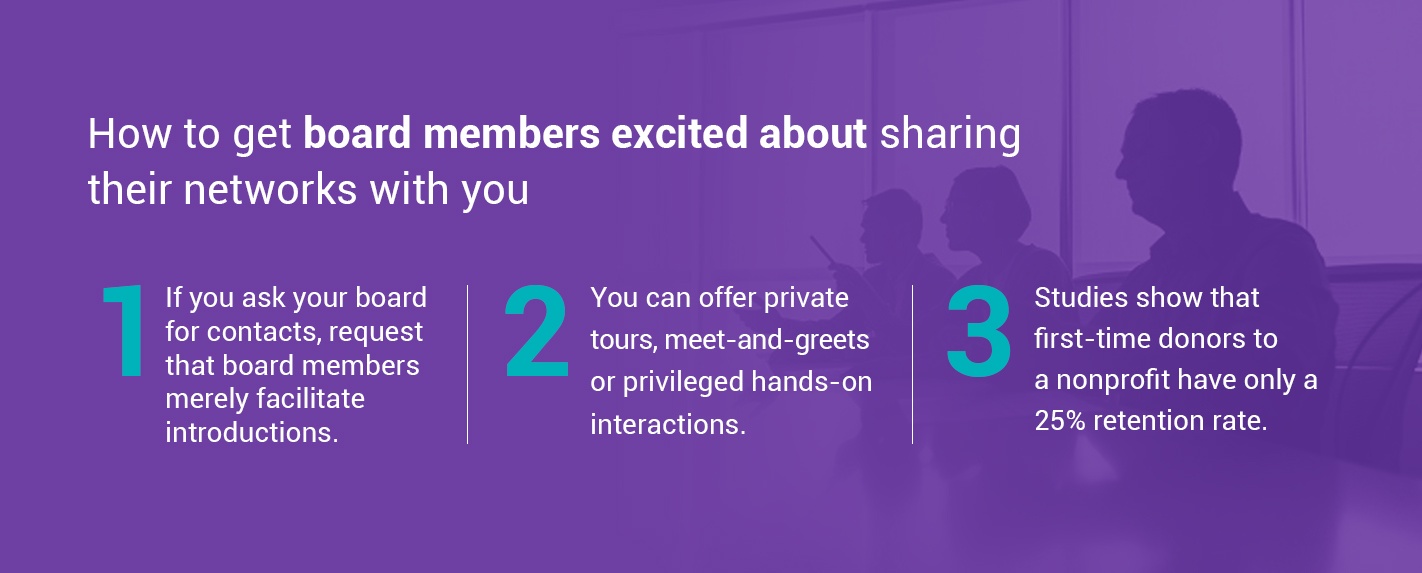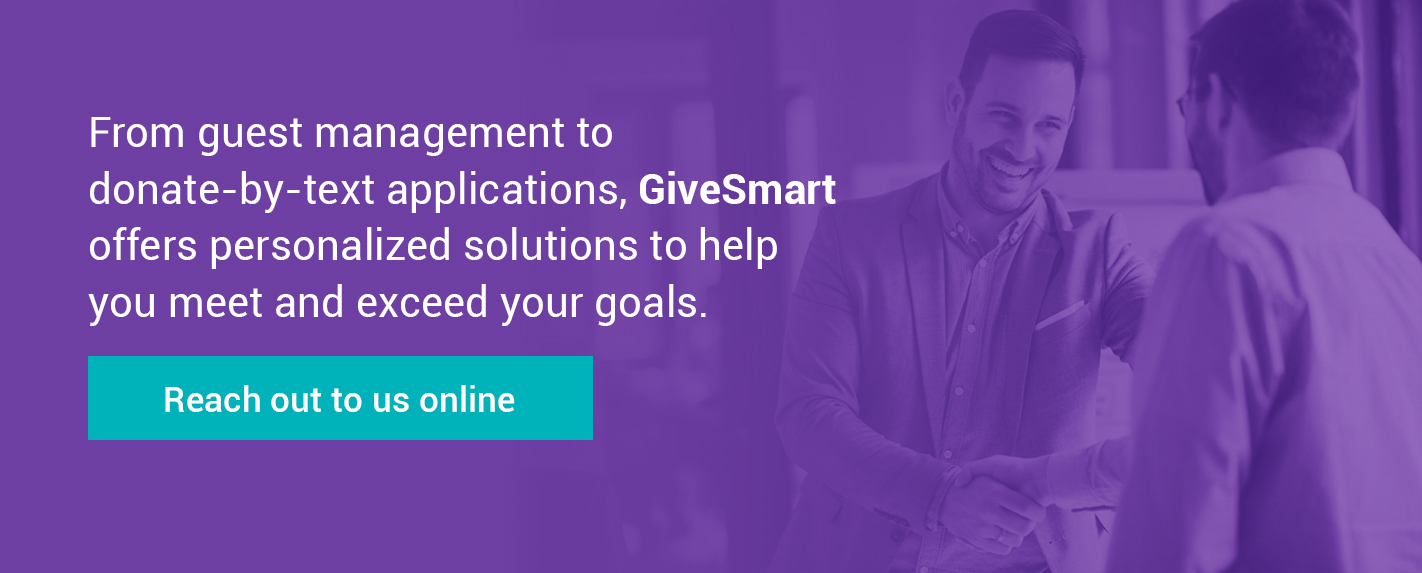Jul 26, 2019
How to leverage your nonprofit board’s donor network

Every nonprofit dreams of having more donors. There’s always more to strive for, and there are always areas where more funding would make a world of difference in the work you do. Making new connections provides novel opportunities to help your nonprofit increase its impact.
More than half of nonprofits struggle with fundraising. Additionally, only 42% of nonprofit executives and staff believe their boards play a very strong role in fundraising opportunities. So reaching out to your board for help in cultivating more donors can provide a valuable boost to your fundraising efforts.
Leveraging your board’s network is vital. Your board members can facilitate connections. They can talk up your mission and provide a springboard for you to articulate your vision and explain the profound impact a donation to your organization would make. Board fundraising efforts help you create a donor network that transforms your giving revenues.
Why your board’s network is your most valuable asset
Your board’s network is your most valuable asset for several reasons:
1. They know more people than you do
Your board members undoubtedly have friends with similar interests and philanthropic bents. Your board members probably have several friends or acquaintances who would be a good fit for your organization, and a nonprofit board’s professional contacts may number in the dozens. This network is a deep mine to tap into. Your development team can cultivate relationships if the board members are willing to provide the introduction.
We know that many nonprofits struggle with fundraising efforts. But when nonprofits engage their boards in fundraising, 60% reach their goals, as opposed to 53% of those who don’t engage their boards. When the board has a committee that focuses specifically on fundraising, 63% of organizations reach their goals. Thus it’s wise to lean on your board to facilitate introductions and help develop your network.
2. Their contacts have more money than you do
Some of your board members likely sit on the boards of more than one organization. In that case, they probably have many contacts with financial resources and the desire to invest them in the community.
Your board members can also tap into their social circles. Maybe a board member of your cat shelter plays squash every Tuesday with a bank CEO, and that CEO has rescued three cats of her own. Or perhaps a member of your conservation group’s board goes backpacking with a hedge fund manager, and that manager is likewise passionate about reducing energy consumption and protecting natural resources.
A nonprofit board fundraising strategy that leverages those connections stands to solidify its financial footing and support its mission well.
3. Their contacts have their own networks of influence
If every one of your board members leads you to a few new contacts, that’s a promising start. But imagine every one of those contacts leading to you more, in a sort of nonprofit prospect pipeline. Now, instead of dozens of potential new donors, you have hundreds.
Reaching out to your board for new contacts leads to the prospect of even more new contacts down the line. This unfolding of your network leads to opportunities for cultivating new, fruitful relationships as years pass.
4. Personal connection outperforms universal appeals
Universal appeals are easy to ignore. Many of us delete mass emails without a second thought. A fun social media post might get hundreds of likes and comments, but how many of those “awwwwww!” comments on a photo of reading with cute schoolkids will turn into action?
A personal connection is different. Because there’s an established relationship in place, you can appeal to the emotional investment that already exists. Leverage your nonprofit board’s community ties to boost your network.
Reasons board members are cautious about sharing their network contacts with you
Predictably, board members sometimes feel reluctant to give out contact information for their friends and associates. Understanding why is the first step to maintaining a good relationship and earning donor prospects from your board.
1. They want to keep their business and personal lives separate
As much as your board members may love your organization and the work it does, they also don’t want their charitable work to bleed into their personal lives. They want to keep their good relationships with you distinct from the good relationships they have with their family and friends to maintain a healthy work-life balance.
If you lean on your board for prospective donors, make it clear that you value their personal lives and connections too.
2. They want to keep their personal relationships stress-free
Though your board members are happy to work for your nonprofit, it’s different when they’re asking rather than giving.
Your board members want their relationships with friends and associates to remain positive and free from obligation. They don’t want to feel as if, after they’re successful once, they’ll have to keep circling back like sharks, sniffing for more and more funds.
3. They want to protect their contacts
Your board members want to provide their friends and acquaintances with positive experiences. They want to keep their friends from feeling spammed or unduly obligated.
Imagine a potential donor who works, serves on the board of the local hospital, provides funds for area startups and has children to provide for as well. Your board member knows that even though this person loves the opera, they have finite resources, and your board member doesn’t want to make them feel pressured give more than they can.
How to get board members excited about sharing their networks with you
Despite some initial reluctance, you can persuade board members to share their contacts with you by earning their trust. Earning trust is vital when you’re thinking about how to create a board fundraising plan.
1. Keep it low-key
If you ask your board for contacts, request that board members merely facilitate introductions. They are more likely to do that than to want to be part of a direct monetary transaction.
Though board members may be reluctant to drop their entire contacts list on you, you’ll get at least a few names to start with, and those few names will lead to more.
2. Offer something first
Using your board to generate fundraising prospects doesn’t work if your board just feels used. As in many professional relationships, you have to give something to get something. You can offer private tours, meet-and-greets or privileged hands-on interactions. Offer dinner with management staff so new contacts can learn more about the organization, its mission and its day-to-day functions.
You could also give out invitations to engaging seminars on current topics, provide free books and calendars, or offer a chance for sleepovers in cool exhibits if you’re fundraising for the local museum or aquarium.
3. Emphasize relationships
Studies show that first-time donors to a nonprofit have only a 25% retention rate. Personal relationships change that by supplying a meaningful connection that leads to long-term investment in the welfare of the organization.
When it comes time to get serious about your fundraising campaign, don’t ask if you can contact your board’s network — ask whom you can contact. Emphasize the connections that your organization has with the community and the meaningful personal relationships new donors can build if they so choose.
If board members supply contacts who become valued donors, board members themselves will feel more connected to your nonprofit. They will be pleased that they could provide a valuable service to your organization, and your relationship will deepen and grow.
The value of great events
One of the most successful ways to get your board more involved with your fundraising is to host great events. That way, you can showcase all the good you do and inspire your board members to feel lucky to be part of such a strong and impactful team. Enjoyable, lighthearted events offer several benefits and are an excellent example of how to make board outreach easy.
1. No direct ask for board member contacts
Imagine that you’re holding a silent auction to benefit zoo research. You’ll provide a limited number of free tickets for board members to invite whomever they wish. Attendees at the auction can bid on animal-themed trip packages, fun zoo events such as behind-the-scenes tours of the nursery or the big cat complex, and staff-made gifts like handmade walking sticks, stunning wildlife photos and more. Even if attendees don’t wish to bid, they can enjoy browsing the items and stuffing themselves with all the buffet items and drinks they desire.
The virtue of this scenario is that you’re not asking attendees for anything directly. They can simply show up, have a good time and go home when the party’s over. But they’ll receive positive exposure to your organization, its values, its competence and what it can do for others, and they’ll remember that positive experience when they’re trying to decide where to donate next.
2. They can invite a wide range from their networks
For a fun event like a silent auction, there’s no limit on whom board members can bring. You’re not trying to cultivate your nonprofit board’s LinkedIn network here. If the auction is for an ocean conservancy, it doesn’t matter if attendees know anything about biology or oceanography.
Just about everyone likes to eat, drink and make merry. Everyone loves to see pictures of cute dolphins and hear stories about dramatic close encounters in the wild. Doctors, bankers and people from all walks of life can come together around the grave issues of climate change and ocean pollution that affect us all.
Big events give your nonprofit exposure to people who might not otherwise have given you a second thought. The great experience those people have will make them remember you and think about you more often.
3. Events are fun and engaging
The big, bold fundraising events your nonprofits host are exactly the type of experience board members want to share with their contacts. These events are fun and exciting, and they bring people together to participate and enjoy.
If your nonprofit is a pediatric illness support group, consider a dance-a-thon to get both kids and adult attendees, up, moving and laughing. If your nonprofit is an animal rescue, try an end-of-the-night “cats versus dogs” bidding war that will get people engaged, shouting and cheering.
No matter what route you choose, a successful, fun event leaves board members and their guests glad for the relationship you have and delighted to develop more.
How to keep board members engaged in fundraising
A nonprofit fundraising retention plan is essential. To keep board members engaged and donors invested, try a few of these strategies:
1. Beware of donor fatigue
Be judicious about how and when you ask for help. Many donors, including your board remembers, would rather give generously once or twice a year than be bombarded with small requests at every turn.
2. Emphasize specific goals
Have clear goals, and show your board members how they and their contacts contribute directly to reaching those goals. Try focusing on a specific program or time-sensitive crisis. If board members and their donors feel that their impact is tangible and personal, they are more likely to stay involved.
3. Do some of the work
Give your board members scripts to follow and bullet points to hit when they’re speaking about you and the incredible work you do. Or create social media posts and encourage them to share with their networks. Of course, they can personalize their messages, but giving them the scaffolding to stand on goes a long way toward making them want to participate in outreach.
4. Make it personal
Maybe a board member won a South American wine-tasting trip at your silent auction last year. This year, ask her to create a photo collage and speak about her experience. Or maybe a few students she tutored made an impact on her, and she can present on the rewards of those relationships. Use personal investment to feedback into the organization and its fundraising operation.
5. Show your appreciation
Take time to appreciate valuable time and resources that your board members provide for you. Write thank-you notes or make thank-you calls to your board members. Give small gifts. Use positive reinforcement to highlight the value of their contributions, and measure how far their contributions went and the specific good that they did. Celebrate their successes and show your gratitude.
Boost your fundraising efforts with GiveSmart
There’s a lot to think about when you’re evaluating fundraising techniques and events management. Partnering with GiveSmart allows you to transform your nonprofit’s fundraising strategies and reap measurable rewards. From guest management to donate-by-text applications, GiveSmart offers personalized solutions to help you meet and exceed your goals.
If your nonprofit plans to host a fundraising event, or if you’re looking for a platform to help your donors give in a smart, easy way, take a look at what GiveSmart has to offer. Reach out to us online, or feel free to give us a call.
Related







